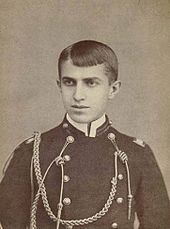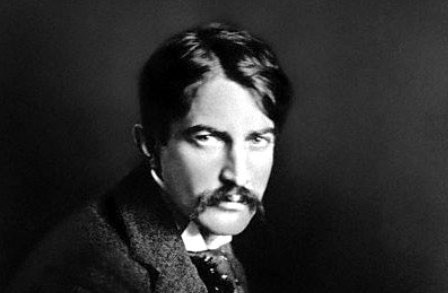
At the tender age of 28, author Stephen Crane succumbed to tuberculosis and passed away at a German health spa. Despite his young age, Crane had accomplished what many take several decades of adulthood to achieve – fame, success, scandal, sickness and health. He lived a full life and was not afraid of standing up for himself and for others. Let’s learn a bit more about this famed American author, shall we?
 Crane was born on November 1st, 1871 in Newark, New Jersey, the 14th child (of only 8 surviving children) to a clergyman and daughter of a clergyman. Crane began writing at an early age, and when he was eight years old he wrote his first surviving poem – “I’d Rather Have A-” – a poem about wanting a dog for Christmas! One year later he began formal schooling and completed two grades within a six week period. Throughout Crane’s education he was a slightly erratic student, if intelligent and somewhat popular. This could be put down to the fact that by the time Crane was a teen, quite a few members of his family (his father and siblings) were dead – leading to a very different childhood than his classmates.
Crane was born on November 1st, 1871 in Newark, New Jersey, the 14th child (of only 8 surviving children) to a clergyman and daughter of a clergyman. Crane began writing at an early age, and when he was eight years old he wrote his first surviving poem – “I’d Rather Have A-” – a poem about wanting a dog for Christmas! One year later he began formal schooling and completed two grades within a six week period. Throughout Crane’s education he was a slightly erratic student, if intelligent and somewhat popular. This could be put down to the fact that by the time Crane was a teen, quite a few members of his family (his father and siblings) were dead – leading to a very different childhood than his classmates.
Crane was interested in baseball, the military, and writing. After enrolling in college under an engineering degree, he eventually left at the age of 20, declaring college a waste of time! He moved in with his older brother Edmund in New Jersey, but made frequent trips into The Bowery slums of New York City where he found human nature to be open and unaffected. He entered into a brief relationship with a married woman and wrote some controversial free-lance work on local events – beginning to make a name for himself solely out of scandal. In the next two years, after moving to New York, Crane worked on what would become his first novel, A Girl of the Streets (the Maggie would be added later). The novel about the girl who becomes a prostitute out of pitiable circumstances unfortunately needed to be self-published privately by Crane himself. He printed 1,100 copies and spent $869 to do so. Despite Maggie receiving praise for its truthful account of life in the slums, it did not garner the enthusiasm or scandal that Crane hoped for and he ended up giving away the last hundred copies for free.
 In 1893 Crane became frustrated with stories written about the Civil War, stating “I wonder that some of those fellows don’t tell how they felt in those scraps. They spout enough of what they did, but they’re as emotionless as rocks.” Crane decided to write an account of a soldier in the war, and began work on what would become The Red Badge of Courage, Crane’s most beloved work to date. His story would be different from his contemporaries – for he wanted desperately to present a “psychological portrayal of fear” by describing a young man disillusioned by the harsh truths of war. He succeeded and a year later his novel began to be published in serial form by the Bacheller-Johnson Newspaper Syndicate. It was heavily edited for publication in the serial, though it did begin to cause a stir in its readers. Crane then worked on a book of poetry, which was published to large amounts of criticism due to his use of free verse, not then a common convention. Crane was not bothered by its unpopular reception – he was instead quite pleased that the book made “some stir” and caused a reaction of any sort. In 1895 Appleton published The Red Badge of Courage, the full chapters, in book form – and Crane became a household name overnight. The book was in the “top six on various bestseller lists around the country” for months after its publication. It even became popular abroad and was widely read in Great Britain as well. Crane was only 23 years old at the start of his fame.
In 1893 Crane became frustrated with stories written about the Civil War, stating “I wonder that some of those fellows don’t tell how they felt in those scraps. They spout enough of what they did, but they’re as emotionless as rocks.” Crane decided to write an account of a soldier in the war, and began work on what would become The Red Badge of Courage, Crane’s most beloved work to date. His story would be different from his contemporaries – for he wanted desperately to present a “psychological portrayal of fear” by describing a young man disillusioned by the harsh truths of war. He succeeded and a year later his novel began to be published in serial form by the Bacheller-Johnson Newspaper Syndicate. It was heavily edited for publication in the serial, though it did begin to cause a stir in its readers. Crane then worked on a book of poetry, which was published to large amounts of criticism due to his use of free verse, not then a common convention. Crane was not bothered by its unpopular reception – he was instead quite pleased that the book made “some stir” and caused a reaction of any sort. In 1895 Appleton published The Red Badge of Courage, the full chapters, in book form – and Crane became a household name overnight. The book was in the “top six on various bestseller lists around the country” for months after its publication. It even became popular abroad and was widely read in Great Britain as well. Crane was only 23 years old at the start of his fame.
At 24, Crane was involved in a scandal that shaped his reputation for life. While accompanying two young ladies home in the evening, one of the ladies was arrested by an undercover policeman on charges of attempted prostitution. The woman was charged and Crane remained adamant that the ladies he was with were innocent – leading the world to remark on his Courage at standing by the alleged prostitute. The praise for Crane quickly turned sour, however, when the arrested lady pressed charges against the policeman that solicited her and Crane was called on to be a witness. Police of New York wrecked havoc on Crane’s life when he was targeted by the Defense – they sought to portray him as immoral and a frequent visitor of brothels and drug addicted – Crane’s courageous reputation was stripped quite quickly. Crane escaped to Cuba to work as a war correspondent at the age of 25. While awaiting his trip to Cuba in Jacksonville, Florida, Crane met the slightly older brothel owner Cora Taylor and began a relationship with her. However, after a few months Crane was granted travel to Cuba on the SS Commodore and he left Cora to travel. After only 2 days on the Commodore, the ship struck ground twice and began to sink. Crane and other men on the vessel boarded a 10-foot dinghy and attempted for days to land the boat on Daytona Beach. The waves were large and the boat eventually overturned and the men swam to shore. Cora traveled to Daytona to bring the weary Crane back, and eventually Crane would recount the event in his famous story “The Open Boat”, published in 1897.
 Crane became a war correspondent alongside Taylor in the Greek-Turkish War of 1897, and then the Spanish-American War in 1898. Unfortunately for Crane this year was the beginning of the end, as his health worsened and none of his work ever sold as well as The Red Badge of Courage. He was a few thousand dollars in debt and worked writing feverishly to try to support both him and Taylor, who was living in England. He moved to England in January of 1899, writing for literary magazines there, but his health rapidly declined and by June of 1900 he was in a health spa in Germany, dictating his work to Taylor. He passed away from tuberculosis the same month, and left all of his work and livelihood to Taylor. Despite dying at such a young age, Crane, whose work was re-birthed in the 1980s after suffering a spell of unpopularity, is now taught in high schools across the country, as his most famous work is recognized as a highly naturalistic and realistic view of war through the eyes of a young American. Happy Birthday to Stephen Crane!
Crane became a war correspondent alongside Taylor in the Greek-Turkish War of 1897, and then the Spanish-American War in 1898. Unfortunately for Crane this year was the beginning of the end, as his health worsened and none of his work ever sold as well as The Red Badge of Courage. He was a few thousand dollars in debt and worked writing feverishly to try to support both him and Taylor, who was living in England. He moved to England in January of 1899, writing for literary magazines there, but his health rapidly declined and by June of 1900 he was in a health spa in Germany, dictating his work to Taylor. He passed away from tuberculosis the same month, and left all of his work and livelihood to Taylor. Despite dying at such a young age, Crane, whose work was re-birthed in the 1980s after suffering a spell of unpopularity, is now taught in high schools across the country, as his most famous work is recognized as a highly naturalistic and realistic view of war through the eyes of a young American. Happy Birthday to Stephen Crane!

